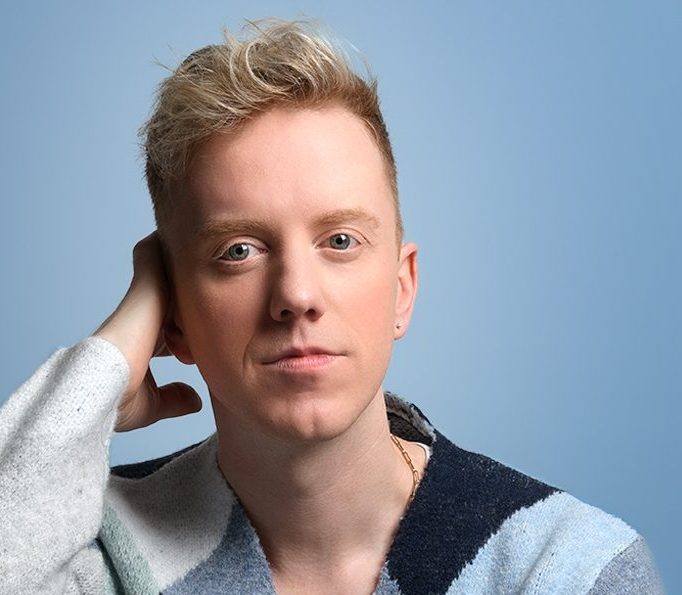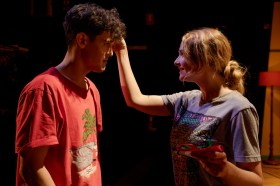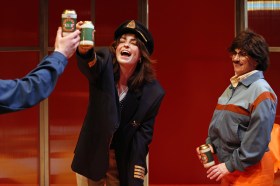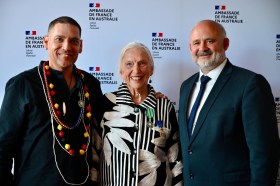Susie McCabe: Merchant of Menace
★★★★★
‘D’ye remember the time we had a Prime Minister who looked like he’d slept in a bin?’
Susie McCabe ambles out on a Tuesday night to a packed house of 300. ‘I thought it’d be a nice cruisey Tuesday, nae too many punters, nae fuss, jest a nice wee little chat wi me chums.’ Immediately she feels like a best friend. She’s eminently likeable and you settle in for a night of fun. She banters with the audience, finding out where everyone comes from. They’re mostly Scottish and English with a handful of Americans and Australians thrown in.
‘How’s the weather?’ She says, ‘23 degrees and f***en HOSING it down!’
McCabe is down to earth, refreshingly honest and as real as it comes. The kind of human you can trust and the kind of comedian who has you falling on the floor laughing.
She tells us she got married last year. For the second time. She says gay divorce is a minefield. ‘It’s a bunch of gays and lesbians locked in custody battles over their pets. I get to take my dog to McDonald’s every second weekend.’ Everything is delivered with a casual dry ease, as though she’s just having a pint with you at the pub. She talks about the wedding. ‘Of course ye know what lesbians get as wedding gifts? A power drill and a pump!’
She tells us she and wife Nicola booked a fancy hotel for their honeymoon. ‘They can always tell we’re working-class cos we wear our best clothes to check in. It dates back to our mums, doesn’t it? “Go get yer good shoes on! NOW!” She says they both brought their best pyjamas but of course they don’t wear them the first night because there’s some business to get down to, but the second night she puts them on because, ‘I’ve done 25,000 steps today, I hope she’s OK with a biscuit and a cup of tea!’
After a day spent watching serious theatre, McCabe is just what this reviewer needs. She is laugh-out-loud, pants-peeing funny and her brand of working-class humour is hugely popular with the mostly Scottish audience. For anyone travelling to Edinburgh looking for a brilliant Scottish cultural experience, look no further than McCabe. Much like Billy Connolly, her comedy is tough, cheeky, down to the bone and screamingly funny.
Susie McCabe: Merchant of Menace will be performed at Studio Three Assembly George Square until 25 August 2024.
Todd Almond: I’m Almost There
★★★★★
‘So I joined a cult. The pyramid scheme. The people were nice. I gave them all my money.’
I’m Almost There is mental. Well and truly mental, in the best possible way. Written and performed by New York darling Todd Almond and from the producers of Fleabag and Baby Reindeer, this hysterical piece of music theatre is a wacky, stream-of-consciousness, ADHD-inspired trip through the protagonist’s search for love and the weird cast of characters he meets along the way.
Almond jumps randomly from story to story and does it all at his piano, telling his stories through song with Erin Hill on harp and vocals, occasionally interjecting as the crazy cat lady who sells pyramid schemes, and Luke McCrosson on bass, who plays the sexy neighbour across the hall.
There’s also the vampire downstairs who eats blood popcorn, the old man he finds lying on the ground, the rich gays whose party he leaves, the sweet guy from the dating site, his suicidal cat, the spiders in his head, the dead mouse in the basement, the song about his favourite writer Joyce Carol Oates and why it’s good to do jury duty.
Each story/song is delivered with droll, deadpan humour and impeccable comic timing. And then suddenly, in the middle of all this hysteria and madness, there’s an exquisite song about love and loss that is infused with pathos and poignancy … which he cuts short because he needs to do his laundry.
Almond is singing to a packed house of 200 and it’s easy to see why. The man is a comic and musical genius. I’m Almost There is unlike anything this reviewer has ever seen before. It’s an example of rampant creativity gone wild and my favourite kind of crazy.
I’m curious to know what Almond’s creative process is. It seems as if he must sit at his piano to write a song and write the first thing that comes to mind, no matter how bizarre. But if his choice of material is random and madcap, the work he puts into the structuring of the material and the creation of the songs is not. This is a seriously good artist at the top of his game, and I’m Almost There is everything you look for in a brilliant Fringe show.
Todd Almond: I’m Almost There will be performed at Summerhall Main Hall until 26 August.
James Barr: Sorry I Hurt Your Son (Said My Ex to My Mum)
★★★★
‘Then God saved me … by killing the Queen. I was having a s**t time, so the national period of mourning felt like it was about me.’
British radio darling James Barr is following in the footsteps of the ground-breaking Hannah Gadsby with his brave new show, Sorry I Hurt Your Son (Said My Ex to My Mum), which covers, among other things, his experience of domestic abuse. Directed by same director who directed Gadby’s Netflix special, Madeleine Parry, Barr teeters precariously on the border of comedy and tragedy, making his audience laugh at his acerbic brand of humour (‘I’ve slept with over a 100 men. I get it from my mum. If she were an egg she’d be called over-easy’) and cringe over his gross-out jokes (too gross to quote, but very funny), before stunning them into silence with his description of childhood bullying from his brother and violence from his ex (‘I’m a Virgo and he’s a-busive’).
He navigates the transitions well, and the result is a deeper and more interesting comedy experience that combines humour and pathos. ‘I used to do dick jokes. Now I do trauma.’
Barr explains that he’s chosen to tell his story of abuse because silence is traumatising and he hopes that, in telling his story, he can help others speak out if they too are suffering domestic abuse in silence. He also comes up with some deep and salient observations about the impact of domestic abuse. In describing his ex he says, ‘They became a victim of their past and I became a victim of their present.’ And then, ‘There’s violence inside me now. He’s given me that.’
It’s exciting to witness an artist take risks at Fringe, and fascinating to watch someone break the rules of their chosen craft … and succeed. It’s also novel to witness a comedian show their vulnerability and inspiring to see how they use humour to deal with the slings and arrows life has dealt them. When Barr finally discloses the abuse to a Botox practitioner who then, in solidarity tells him her domestic abuse story, he says, ‘She saved me with her story. I wanted to cry … but my Botox had taken hold.’
This is edgy, risky comedy and Barr has gone right out on a limb in choosing to use comedy to tell his difficult story. Kudos to him for pulling it off. His final line is an absolute banger and he meets all the criteria this reviewer looks for in seeking unique, genre-defying Fringe performance.
James Barr: Sorry I Hurt Your Son (Said My Ex to My Mum) will be performed at Underbelly Buttercup at Bristo Square until 25 August.
Stella Graham: Phoenix
★★★★
Stella Graham is grounded, relaxed and friendly. Her pleasant demeanour, pretty face and winning smile hide the fact that there’s a highly subversive provocateur lurking beneath the surface. Her brand of comedy is irreverent, honest and understated.
Her mother died during the Fringe last year, but fear not, as she speaks of all the fun they’re having now she’s effectively more portable. She picks up an urn with her mother’s ashes. (The audience howls).
What follows is an utterly hilarious, no-holds-barred show about Graham’s ahem, “challenging” mother. It includes her mother’s fixation on younger men and favouritism among her nine children.
Her favourite was Graham’s brother, who lives in LA and has barely anything to do with her.
Plenty of photos of him around the house, but none of the comic herself. She hasn’t seen him in years. Graham and her sisters are the ones who have to look after her.
There are many shows at Fringe that deal with grief, loss and difficult mothers, but none quite like the one by Graham. Somehow, she manages to honour her mother without holding back on what an absolute nightmare she was. Her love is there in the subtext but she tells her story without an ounce of sentimentality and an outrageous irreverence which is fitting, because it sounds like she inherited it from her mother in the first place.
Read: Festival review: Tending, Edinburgh Festival Fringe
This was a laugh-a-minute stand-up routine that could easily translate into a terrific one-woman show. Graham is quietly confident and at ease with her material and immensely likeable. Her comic writing is A grade and her delivery is humble, sly and understated. And the best thing is, she’s performing for PBH Free Fringe, so if you’re too broke to afford to go to shows you can still go see her and have a laugh.
Stella Graham: Phoenix will be performed at The Voodoo Rooms until 25 August as part of PBH Free Fringe.






